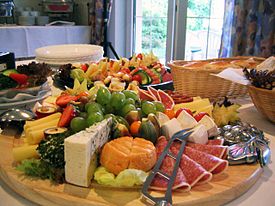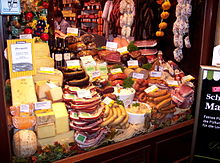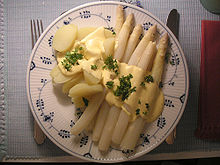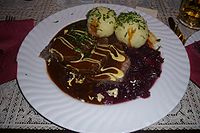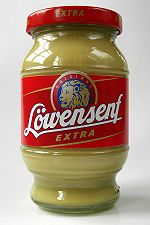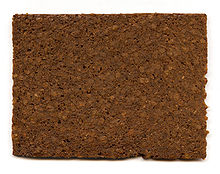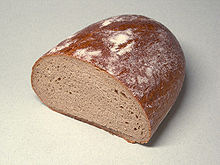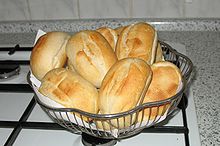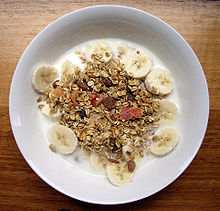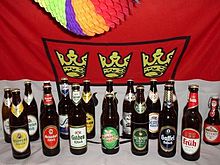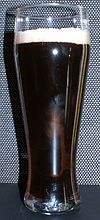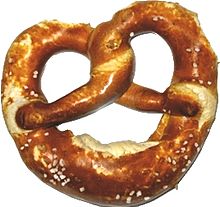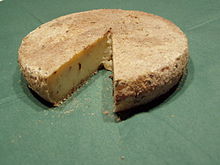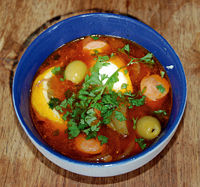- German cuisine
-
German cuisine is a style of cooking derived from the nation of Germany. It has evolved as a national cuisine through centuries of social and political change with variations from region to region. The southern regions of Germany, including Bavaria and neighbouring Swabia, share many dishes. Furthermore, across the border in Austria one will find many similar dishes. However, ingredients and dishes vary by province. There are many significant regional dishes that have become both national and regional. Many dishes that were once regional, however, have proliferated in different variations across the country into the present day.
Contents
Staple foods
Meat
Pork, beef, and poultry are the main varieties of meat consumed in Germany, with pork being the most popular. The average person in Germany will consume up to 61 kg (130 lb) meat in a year.[citation needed] Among poultry, chicken is most common, although duck, goose, and turkey are also enjoyed. Game meats, especially boar, rabbit, and venison are also widely available all year round. Lamb and goat are also available, but are not as popular.
Meat is usually pot-roasted; pan-fried dishes also exist, but these recipes usually originate from France. Several cooking methods used to soften often tough cuts have evolved into national specialties, including Sauerbraten, involving marinating beef or venison in a vinegar or wine vinegar mixture over several days. A long tradition of sausage-making exists in Germany, including hundreds of regional variations. There are more than 1500 different types of sausage (German: Wurst)[1] in Germany. Most Wurst is still made by German sausage makers (German: Metzger) with natural casings derived from pork, sheep or lamb intestine. Among the most popular and most common are the Bratwurst, usually made of ground pork and spices, the Wiener, which may be pork or pork/beef and is smoked and fully cooked in a water bath, and Blutwurst or Schwarzwurst made from blood (often of pigs or geese). There are literally thousands of types of cold cuts. Regional specialties, such as the Münchner Weißwurst popular in Bavaria, can also be found from all regions of the country.
Fish
Trout is the most common freshwater fish on the German menu; pike, carp, and European perch also are listed frequently. Seafood traditionally was restricted to the northern coastal areas, except for pickled herring, often served as Rollmops (a pickled herring fillet rolled into a cylindrical shape around a piece of pickled gherkin or onion) or Brathering (fried, marinated herring). Today many sea fish, like fresh herring, tuna, mackerel, salmon and sardines are well established throughout the country. Prior to the industrial revolution and the ensuing pollution of the rivers, salmon were common in the rivers of Rhine, Elbe, and Oder.
Vegetables
Vegetables are often used in stews or vegetable soups, but are also served as a side dish. Carrots, turnips, spinach, peas, beans, broccoli and many types of cabbage are very common. Fried onions are a common addition to many meat dishes throughout the country. Asparagus, especially white asparagus known in English as spargel (the German name for asparagus), is a common side dish or may be prepared as a main dish. Restaurants will sometimes devote an entire menu to nothing but white asparagus when it is in season. Spargel season (German: Spargelzeit or Spargelsaison) traditionally begins in mid-May and ends on St. John's Day (24 June).
Side dishes
Noodles, made from wheat flour and egg, are usually thicker than the Italian flat pasta. Especially in the southwestern part of the country, the predominant variety of noodles are spätzle, made with large amounts of egg yolk, and maultaschen, traditional stuffed noodles reminiscent of ravioli.
Besides noodles, potatoes are common. Potatoes entered the German cuisine in the late 18th century, and were almost ubiquitous in the 19th century and since. Potatoes most often are boiled (in salt water, Salzkartoffeln), but mashed (Kartoffelpüree) and fried potatoes (Bratkartoffeln) also are traditional. French fries, called Pommes frites or Pommes in German, are a common style of fried potatoes; they are traditionally offered with either ketchup or mayonnaise, or, as pommes rot-weiß, with both.
Also common, especially in the south of Germany, are dumplings (including klöße or knödel) and potato noodles including schupfnudel which is similar to Italian gnocchi.
Spices and condiments
Generally, with the exception of mustard for sausages, German dishes are rarely hot and spicy; the most popular herbs are traditionally parsley, thyme, laurel, chives, black pepper (used in small amounts), juniper berries and caraway. Cardamom, anise seed, and cinnamon are often used in sweet cakes or beverages associated with Christmas time, and sometimes in the preparation of sausages, but are otherwise rare in German meals. Other herbs and spices like basil, sage, oregano, and hot chili peppers have become more popular in recent times.
Mustard ("Senf") is a very common accompaniment to sausages and can vary in strength, the most common version being "Mittelscharf" (lit. "medium hot"), which is somewhere between traditional English and French mustards in strength. Düsseldorf and the surrounding area is known for its particularly spicy mustard, which is used both as a table condiment and in local dishes such as Senfrostbraten (roasted steak with mustard). In the southern parts of the country, a sweet variety of mustard is made which is almost exclusively served with the Bavarian speciality Weißwurst. German mustard is usually considerably less acidic than American varieties.
Horseradish is commonly used as a condiment either on its own served as a paste, enriched with cream ("Sahnemeerrettich"), or combined with mustard. In some regions of Germany it is used with meats and sausages where mustard would otherwise be used.
Garlic was long frowned upon for causing halitosis and thus has never played a large role in traditional German cuisine, but has risen in popularity in recent decades due to the influence of French, Italian, Spanish, Portuguese, Greek, and Turkish cuisine. Bear's garlic, a rediscovered spice from earlier centuries, has become quite popular again since the 1990s.
Desserts
A wide variety of cakes and tarts are served throughout the country, most commonly made with fresh fruit. Apples, plums, strawberries, and cherries are used regularly in cakes. Cheesecake is also very popular, often made with quark. Schwarzwälder Kirschtorte (Black Forest cake) is another very well known cake, made with cherries. German doughnuts (which have no hole) are usually balls of yeast dough with jam or other fillings, and are known as Berliner, Pfannkuchen (only in the Berlin area), Kreppel or Krapfen depending on the region. Eierkuchen or Pfannkuchen are large, and relatively thin pancakes, comparable to the French Crêpes. They are served covered with sugar, jam or syrup. Salty variants with cheese, ground meat or bacon exist as well (but aren't usually considered desserts, but main dishes). In some regions Eierkuchen are filled and then wrapped, in others they're cut into small pieces and arranged in a heap. The word Pfannkuchen can either mean German doughnuts (see Berliner) or pancakes (see Eierkuchen), depending on the region.
A popular dessert in northern Germany is "Rote Grütze", red fruit pudding, which is made with black and red currants, raspberries and sometimes strawberries or cherries cooked in juice with corn starch as a thickener. It is traditionally served with cream, but also is served with vanilla sauce, milk or whipped cream. "Rhabarbergrütze" (rhubarb pudding) and "Grüne Grütze" (gooseberry fruit pudding) are variations of the "Rote Grütze". A similar dish, Obstkaltschale, may also be found all around Germany.
Ice cream and sorbets are also very popular. Italian-run ice cream parlours were the first large wave of foreign-run eateries in Germany, becoming widespread in the 1920s. Spaghettieis, which resembles spaghetti, tomato sauce, and ground cheese on a plate, is a popular ice cream dessert.
Bread
Bread (Brot) is a significant part of German cuisine and is considered necessary for a healthy diet. About 600 main types of breads and 1,200 different types of pastries and rolls are produced in about 17,000 bakeries and another 10,000 in-shop bakeries.
Bread is served usually for breakfast and in the evening as sandwiches, but rarely as a side dish for the main meal. The importance of bread in German cuisine is also illustrated by words such as Abendbrot (meaning supper, literally Evening Bread) and Brotzeit (snack, literally Bread Time). In fact, one of the major complaints of the German expatriates in many parts of the world is their inability to find acceptable local breads.
Regarding bread, German cuisine is more varied than that of either Eastern or Western Europe. Bread types range from white wheat bread to grey (Graubrot) to black (Schwarzbrot), actually dark brown rye bread. Most breads contain both wheat and rye flour (hence Mischbrot, mixed bread), and often wholemeal and whole seeds (such as linseed, sunflower seed, or pumpkin seed) as well. Darker, rye-dominated breads such as Vollkornbrot or Schwarzbrot are typical of German cuisine. Pumpernickel, a steamed, sweet-tasting bread, is internationally well known, although not representative of German black bread as a whole. Most German breads are made with sourdough. Whole grain is preferred for high fibre. Germans use almost all available types of grain for their breads: wheat, rye, barley, spelt, oats, millet, corn and rice. Some breads are made with potato starch flour.
Germany's most popular breads are:
- Rye-wheat ("Roggenmischbrot")
- Toast bread ("Toastbrot")
- Whole-grain ("Vollkornbrot")
- Wheat-rye ("Weizenmischbrot")
- White bread ("Weißbrot")
- Multi-grain, usually wheat-rye-oats with sesame or linseed ("Mehrkornbrot")
- Rye ("Roggenbrot")
- Sunflower seeds in dark rye bread ("Sonnenblumenkernbrot")
- Pumpkin seeds in dark rye bread ("Kürbiskernbrot")
- Roasted onions in light wheat-rye bread ("Zwiebelbrot")
Bread rolls
Bread rolls, known in Germany as Brötchen (a diminutive of "Brot"), Semmel, Schrippe, Rundstück or Weck / Weckle / Weckli / Wecken, depending on the region, are common in German cuisine. A typical serving is a roll cut in half, and spread with butter or margarine. Cheese, honey, jam, Nutella, meat, fish, or preserves are then placed between the two halves, or on each half separately, known as a "Belegtes Brötchen".
Rolls are also used for snacks, or like a hot-dog/hamburger style roll for Bratwurst, Brätel, or Schwenker/Schwenkbraten.
A sweet roll which originated in the area of Hamburg is the Franzbrötchen, small, sweet pastry, baked with butter and cinnamon.
Structure of meals
Breakfast (Frühstück) commonly consists of bread, toast, and/or bread rolls with cold cut, cheese or jam ("Konfitüre" or more commonly called "Marmelade"), marmalade or honey, eggs, and strong coffee or tea (milk, cocoa or juice for children). Deli meats, such as ham, salted meats and salami, are also commonly eaten on bread in the morning, as are various cheeses. A variety of meat-based spreads such as Leberwurst (liverwurst) are eaten during breakfast as well.
Traditionally, the main meal of the day has been lunch (Mittagessen), eaten around noon. Dinner (Abendessen or Abendbrot) was always a smaller meal, often consisting only of a variety of breads, meat or sausages, cheese and some kind of vegetables, similar to breakfast, or possibly sandwiches. However, in Germany, as in other parts of Europe, dining habits have changed over the last 50 years.
Today, many people eat only a small meal in the middle of the day at work, and enjoy a hot dinner in the evening at home with the whole family.[citation needed] This is also the reason why the availability of cheap restaurants close to the office or the existence of a factory canteen cannot be assumed automatically.
For others, the traditional way of eating is still rather common, and not only in rural areas. Breakfast is still very popular and may be elaborated and extended on weekends, with friends invited as guests. Since the 1990s the Sunday brunch has also become common, especially in city cafés.
Drinks
Beer is very common throughout all parts of Germany, with many local and regional breweries producing a wide variety of superb beers. The pale lager pilsener, a style developed in the mid-19th century, is predominant in most parts of the country today, whereas wheat beer (Weißbier) and other types of lager are common, especially in Bavaria. A number of regions have local specialties, many of which, like Weissbier, are more traditionally brewed ales. Among these are Altbier, a dark beer available around the lower Rhine, Kölsch, a similar style in the Cologne area, and the low-alcohol Berliner Weiße, a sour beer made in Berlin that is often mixed with raspberry syrup. Since the reunification of 1990, Schwarzbier, which was common in East Germany but could hardly be found in West Germany, has become increasingly popular in Germany as a whole. Beer may also be mixed with other beverages:
- pils or lager and carbonated lemonade (in Europe and the UK, lemonade is a carbonated drink, in America, lemonade is a non-carbonated drink): Radler, Alsterwasser
- pils or lager and cola: Diesel, Schmutziges or simply Colabier
- Altbier and Malzbier: Krefelder
- Altbier and cola: Altcola or Aco (also called Krefelder in some regions, which might lead to misunderstandings)
- wheat beer and lemonade: Russ
- wheat beer and cola: Colaweizen
Since a beer tax law was changed in 1993, many breweries served this trend of mixing beer with other drinks by selling bottles of already-mixed beverages. Examples are Bibob (from Köstritzer), Veltins V+, Mixery (from Karlsberg), Dimix (from Diebels) and Cab (from Krombacher).
Beer is generally sold in bottles or from draught. Canned beer is available, but cans almost vanished after the introduction of a deposit in 2003.
Wine is also popular throughout the country. German wine comes predominantly from the areas along the upper and middle Rhine and its tributaries. Riesling and Silvaner are among the best-known varieties of white wine, while Spätburgunder and Dornfelder are important German red wines. The sweet German wines sold in English speaking countries seem mostly to cater to the foreign market, as they are rare in Germany.
Korn is a German spirit made from malt (wheat, rye and/or barley), that is consumed predominantly in the middle and northern parts of Germany. Obstler on the other hand, distilled from apples and pears ("Obstler"), plums, cherries (Kirschwasser), or mirabelle plums, is preferred in the southern parts. The term Schnaps refers to both kinds of hard liquors.
Coffee is also very common, not only for breakfast, but also accompanying a piece of cake in the afternoon, usually on Sundays or special occasions and birthdays. It is generally filter coffee, which is weaker than espresso. Tea is more common in the Northwest. East Frisians traditionally have their tea with cream and rock candy ("Kluntje").
Popular soft drinks include Schorle, juice or wine mixed with sparkling mineral water, with Apfelschorle being especially popular in southern Germany, and Spezi, made with cola and an orange-flavored drink such as Fanta. Germans are unique among their neighbors in preferring bottled, carbonated mineral water, either plain ("Sprudel") or flavored (usually lemon) to non-carbonated ones.
Drinking water of excellent quality is available everywhere and at any time in Germany. Water provided by the public water industry can be had without hesitation directly from the tap. No chlorine is added. Drinking water is controlled by state authority to ensure it is potable. Regulations are even stricter than those for bottled water (see Trinkwasserverordnung). There is no need at all to buy water in bottles in Germany for health reasons, though the taste of the tap water varies widely.[citation needed]
Regional cuisine
German regional cuisine can be divided into many varieties such as Bavarian cuisine (Southern Germany), Lower Saxon cuisine (Northern Germany), Thuringian (Central Germany) or Saxony-Anhalt (Central Germany).[2]
Bavaria
Main article: Bavarian cuisineLower Saxony
Main article: Lower Saxon cuisineThuringia
Agriculture figures highly in the diet of Thuringia with about half of the state being used for agriculture[citation needed]. Wheat, rapeseed, sugarbeet, and barley grow well, along with a variety of vegetables, which grow near Erfurt, the state's capital. Cauliflower (740 acres (3.0 km2)), cabbage (savoy, red, white) (25 acres (100,000 m2)), kohlrabi (37 acres (150,000 m2)), broccoli (37 acres (150,000 m2)) grow by traditional means near Erfurt. Tomatoes, lettuce, broad beans, onions, and cucumbers are grown in the eastern portion of the region near Jena under glass centers on about 12 acres (49,000 m2) of land. Thuringia is the second largest herb-growing region in Germany; the town of Kolleda was once considered the "peppermint town", where herb growers used to congregate to study herb cultivation.[3]
One-third of Thuringia is covered in forest, and is considered to be one of the best game hunting regions in Germany. Until the unification of East and West Germany, the game meats were reserved for those privileged enough to obtain it in luxury hotels, or it was exported. Today anyone with a proper permit may hunt for game such as red deer, roe deer, wild boar, rabbit, duck, and mouflon (mountain sheep). Pheasant, capercaillie are all protected game species that may not be hunted. The wooded areas also contain a wide variety of edible mushrooms such as chestnut mushrooms, porcini, and chanterelle, along with wild berries such as blueberries, cranberries, raspberries, and blackberries which are all traditional accompaniments to game dishes.[4]
The most famous foods from Thuringia are Thuringian sausages and Thuringian dumplings. The state is also known for its sausages; steamed, scaled, and cured varieties are all prepared. Popular varieties include Thüringer mettwurst (a spreadable cured sausage), Feldkieker (a cured, air-dried sausage dried up to eight months), Thüringer leberwurst (a steamed pork and liver sausage), Thüringer rotwurst (a steamed blood sausage packed in a bladder or other natural casing).[5]
Saxony-Anhalt
Cereal grain cultivation occupies 62% of the cultivated land in Saxony-Anhalt. Wheat, barley, oats, and rye are grown, with the rye being grown near Borde, where the rye is used to make Burger Knäckebrot, a flatbread produced there since 1931. Another ten percent of the cultivated area is planted in sugar beets for conversion to sugar, popularized after the 19th century when the region had an economic boom.[6]
Whitefish have figured into the regional diet after a fisherman introduced them to the Arendsee over 110 years ago. Fishing was once prominent in the Elbe river, which contains 33 of the 40 species of fish caught in the region. Mercury, hexachlorobenzene, DDT, musk compounds and heptachlor have caused the Elbe to become contaminated, so commercial fishing has been banned since 1989.[7]
Würchwitzer Spinnenkäse (Milbenkäse) is a cheese produced in Würchwitz made by allowing quark to sit amongst thousands of dust mites that transforms the cheese into a highly desired delicacy. The mites excrete an enzyme that ripens the cheese; after one month the cheese turns to a yellowish color, after three months it turns reddish brown, and after a year the cheese turns to a blackish lump, which is desirable to some aficionados. The flavor is characterized as being bitter; it is also suggested that the cheese may have curative effects that keep the people who consume it non-allergic to house dust. The mites are consumed along with the cheese.[8]
The Eichstrich
All cold drinks in bars and restaurants are sold in glasses with a calibration mark (Eichstrich) that is frequently checked by the Eichamt (~ Bureau of Weights and Measures) to ensure that the guest is getting as much as is offered in the menu. The Eichamt is a public authority controlling all measurements in sales, health care and so on, i.e., each scale in a German butcher shop or physician's office carries a stamp from the Eichamt, including a date of expiration, to show the weight is correct.
If the liquid of a served drink is below that line, the guest may refuse the drink or require a correctly filled one. A common rule for beer — with foam — is that the liquid-foam-line must not be more than one centimeter below the Eichstrich, otherwise a Munich resident would refuse the Maß at the Oktoberfest.
Specialities from the former German Democratic Republic
The cuisine of the former German Democratic Republic (GDR or East Germany) differed in several ways from the cuisine of West Germany and today's united Germany.
East German cuisine was strongly influenced by Russian, Hungarian, Bulgarian and other Eastern European countries from the 1960s on. East Germans travelled abroad to these countries on holiday and immigrants to East Germany from these countries brought their dishes with them. A typical dish that came to the East German kitchen this way is Soljanka.
Another dissimilarity was the lack of certain spices in the GDR. Oregano, for example, was totally unknown and the price of garlic and Worcestershire sauce reached extremes. Lemon juice had to be replaced with vinegar and instead of capers, Marsh Marigold buds soaked in brine were used. While cooking with wine (as is typical in the wine-growing regions of Franconia and Hesse) was known, the lack of good wine on the East German market reserved this for special occasions. For these reasons Ragout fin (commonly known as Würzfleisch) became a highly sought-after delicacy.
East German cafeterias had a unified cuisine. Over the entire country cafeterias in companies and schools served the same food. The cafeterias were commonly run by the national trading organisation (Handelsorganisation - HO). Dishes on the menu were picked from a list of about 300 dishes that tasted almost the same everywhere, since the recipes were standardised. The lack of supplies and the pressure of cooking for large numbers of people gave rise to several typical East German inventions, such as "Jägerschnitzel" - large and thin slices of Jagdwurst, covered with bread crumbs, pan-fried and served with tomato sauce and noodles and should not be confused with Jägerschnitzel in western Germany, which there means a normal schnitzel served with dark mushroom sauce.
An effort has been made to preserve this cultural East German heritage, and a collection of East German HO recipes are available online in German.[9]
Foreign influences
With the influx of foreign workers after World War II, many foreign dishes have been adopted into German cuisine — Italian dishes like spaghetti and pizza have become a staple of the German diet. Turkish immigrants also have had a considerable influence on German eating habits; Döner kebab is Germany's favourite fast food, selling twice as much as the major burger chains put together (namely Mc Donald's and Burger King, being the only widespread burger chains in Germany). Chinese and Greek food also are widespread and popular. Indian, Vietnamese, Thai and other Asian cuisines are rapidly gaining in popularity. Many of the more expensive restaurants served mostly French dishes for many decades, but since the 1990s, they have been shifting to a more refined form of German cuisine .
See also
- List of German dishes
Notes
- ^ Guide to German Sausages & Meat Products
- ^ "German Regional Food Specialties." Food-links.com. Accessed July 2011.
- ^ Metzger, 13,19.
- ^ Metzger, 20.
- ^ Metzger, 22-25.
- ^ Metzger, 49.
- ^ Metzger, 50.
- ^ Metzger, 60.
- ^ Kirchenweb.at (German)
References
- Metzger, Christine (ed.) Culinaria Germany. Cambridge: Ullmann, 2008.
External links
 Media related to Cuisine of Germany at Wikimedia Commons
Media related to Cuisine of Germany at Wikimedia CommonsEuropean cuisine Sovereign
statesAlbania · Andorra · Armenia · Austria · Azerbaijan · Belarus · Belgium · Bosnia and Herzegovina · Bulgaria · Croatia · Cyprus · Czech Republic · Denmark · Estonia · Finland · France · Georgia · Germany · Greece · Hungary · Iceland · Ireland · Italy · Kazakhstan · Latvia · Liechtenstein · Lithuania · Luxembourg · Macedonia · Malta · Moldova · Monaco · Montenegro · Netherlands · Norway · Poland · Portugal · Romania · Russia · San Marino · Serbia · Slovakia · Slovenia · Spain · Sweden · Switzerland · Turkey · Ukraine · United Kingdom (England • Northern Ireland • Scotland • Wales) · Vatican City
States with limited
recognitionAbkhazia · Kosovo · Nagorno-Karabakh Republic · Northern Cyprus · South Ossetia · Transnistria
Dependencies
and other territoriesÅland · Faroe Islands · Gibraltar · Guernsey · Jan Mayen · Jersey · Isle of Man · Svalbard
Categories:
Wikimedia Foundation. 2010.

